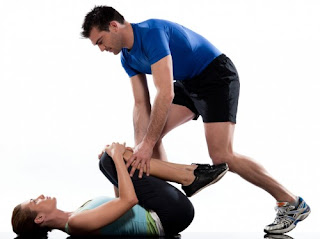Many people spend long periods of time in a seated position. Being seated promotes a flexed spinal posture which, according to back expert and author Stuart McGill, can cause intervertebral discs to bulge outwards resulting in pain and inhibited spinal extension. McKenzie’s exercise series is designed to encourage the displaced disc to move back into its correct position which will alleviate the pain and allow freer spinal movement.
The McKenzie method is a classification system and a classification-based treatment for patients with low back pain. A acronym for the McKenzie method is mechanical diagnosis and therapy (MTD). The McKenzie method was developed in 1981 by Robin McKenzie, a physical therapist from New Zealand.
The aims of the therapy are: reducing pain, centralization of symptoms (symptoms migrating into the middle line of the body) and the complete recovery of pain. The prevention step consists of educating and encouraging the patient to exercise regularly and self-care.
CLASSIFICATION :
Posture syndrome :
Refers to pain which occurs due to a mechanical deformation of normal soft tissue from prolonged end range loading of periarticular structures.
Dysfunction syndrome :
Refers to pain which is a result of mechanical deformation of structurally impaired tissues like scar tissue or adhered or adaptively shortened tissue.
Derangement syndrome :
Refers to pain which is caused by a disturbance in the normal resting position of the affected joint surfaces.
This syndrome is classified in two groups :
Irreducible derangement
The criteria for derangement are present.
No strategy is capable to produce a permanent change in symptoms.
Reducible derangement
Shows one direction of repeated movement which decreases or centralizes referred symptoms / preferred direction.
Other or non-mechanical syndrome
- Spinal Canal stenosis
- Hip disorders
- Sacroiliac disorders
- Low back pain in pregnancy
- Spondylolysis and spondylolisthesis
McKenzie’s exercises are designed to reposition any displaced intervertebral discs. This is initially done by using gravity to draw the discs back into the spine and then actively to consolidate the effect of gravity.
To facilitate disc movement, you must relax as much as possible when performing the exercises and maintain relaxed and even breathing for the duration of the exercise. McKenzie’s exercises can be categorized as either passive or active and the passive exercises should always be performed first.
STAGES OF EXERCISE :
1. Lying Prone Back Exercise :
The patient takes place at the treatment table in prone position. The arms have to be parallel with the thorax, with the hands next to the pelvis. The head is turned to one side. This position creates automatically a lordosis of the lumbar spine. Although this position may be painful, the pain does not indicate the procedure is undesirable if it is felt centrally.
Patients with posterior derangement should be careful when arising from the position to standing. It is important that, while arising, the restored lordosis is maintained.
In any kind of derangement it is important to perform the exercise long enough (5-10 minutes) for the fluid to alter its position anteriorly.
For example patients with lumbar kyfosis, it is possible that the patients cannot tolerate the prone position unless they are lying over a few pillows.

prone lying Back Exercise
2. Extension in Prone Lying :
The patient lies on his abdomen while the hands are placed near the shoulders. The hands are placed with the palms down. Now the patient makes a press-up movement with straight arms. The Pelvis stays near the table while the patient presses the thorax upwards. After this movement the patient returns to his starting position and repeats this exercise 10 times.
The aim of this exercise is to make the lumbar spine relax after the maximum extension, in the relaxation phase.
It is possible that there occurs central low back pain described as a strain pain, but it will gradually wear off.
This procedure is the most important and effective in the treatment of derangement as well as extension dysfunction.
 |
| extension on elbow |

extention on hand
3. Standing Lumbar Extension :
The patient stands up straight with his feet apart, to remain a stable position. The hands are placed on the lumbar region, in the area of the spina iliaca posterior superior. His hands fixate the pelvis while the patient leans backwards. The patient has to lean backwards as far as possible.
It is used mainly in preventing future back problems once your acute pain has resolved. It can also be used as an alternative to prone press ups if social situations don't allow you to lie flat on the floor and exercise, but you need to extend your spine to manage your back pain.
 |
| extension in standing |
To do the exercise, lie on your side (typically on the side with the most pain), and bend your knees. Straighten your bottom leg, and tuck your top foot behind your bottom knee. Slowly reach your upper hand to your shoulder blade, and rotate your spine by moving your top shoulder back and towards the floor. Repeat the exercise for 10 repetitions.
If you have tried the press up with hips off center and the standing side glide exercise and are still having symptoms, you may want to move on to the flexion rotation stretch for low back pain. This stretch can be done to treat back pain on one side or pain that is traveling down your leg.
Self-treatment exercises :
Rest position for cold pack
Sphinx-movement
standing back extension
Pelvic side shift
This exercise is called a “mirror exercise” and can be helpful when you have a “blocked” back and you’re leaning to one side because of it. The patient has to lean with his upper body against the wall, while his feet take same distance from the wall. Now the patient has to move his pelvis against the wall and back to the beginning position. This exercise has to be repeated 8-10 times.
 |
| McKenzie Method Exercise |













